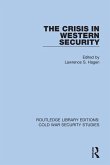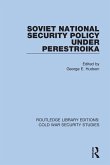- Gebundenes Buch
- Merkliste
- Auf die Merkliste
- Bewerten Bewerten
- Teilen
- Produkt teilen
- Produkterinnerung
- Produkterinnerung
Tongfi Kim is Assistant Professor of international affairs at Vesalius College in Brussels
Andere Kunden interessierten sich auch für
![A Chronology of European Security and Defence 1945-2006 A Chronology of European Security and Defence 1945-2006]() Julian Lindley-FrenchA Chronology of European Security and Defence 1945-2006287,99 €
Julian Lindley-FrenchA Chronology of European Security and Defence 1945-2006287,99 €![The Crisis in Western Security The Crisis in Western Security]() The Crisis in Western Security160,99 €
The Crisis in Western Security160,99 €![Soviet National Security Policy Under Perestroika Soviet National Security Policy Under Perestroika]() Soviet National Security Policy Under Perestroika180,99 €
Soviet National Security Policy Under Perestroika180,99 €![Central European Security Concerns Central European Security Concerns]() Central European Security Concerns159,99 €
Central European Security Concerns159,99 €![Forging the Sword Forging the Sword]() Benjamin JensenForging the Sword131,99 €
Benjamin JensenForging the Sword131,99 €![The Nuclear Renaissance and International Security The Nuclear Renaissance and International Security]() The Nuclear Renaissance and International Security90,99 €
The Nuclear Renaissance and International Security90,99 €![Transforming Command Transforming Command]() Eitan ShamirTransforming Command131,99 €
Eitan ShamirTransforming Command131,99 €-
-
-
Tongfi Kim is Assistant Professor of international affairs at Vesalius College in Brussels
Hinweis: Dieser Artikel kann nur an eine deutsche Lieferadresse ausgeliefert werden.
Hinweis: Dieser Artikel kann nur an eine deutsche Lieferadresse ausgeliefert werden.
Produktdetails
- Produktdetails
- Verlag: Stanford University Press
- Seitenzahl: 256
- Erscheinungstermin: 13. April 2016
- Englisch
- Abmessung: 236mm x 156mm x 22mm
- Gewicht: 477g
- ISBN-13: 9780804796965
- ISBN-10: 0804796963
- Artikelnr.: 44382949
- Herstellerkennzeichnung
- Libri GmbH
- Europaallee 1
- 36244 Bad Hersfeld
- gpsr@libri.de
- Verlag: Stanford University Press
- Seitenzahl: 256
- Erscheinungstermin: 13. April 2016
- Englisch
- Abmessung: 236mm x 156mm x 22mm
- Gewicht: 477g
- ISBN-13: 9780804796965
- ISBN-10: 0804796963
- Artikelnr.: 44382949
- Herstellerkennzeichnung
- Libri GmbH
- Europaallee 1
- 36244 Bad Hersfeld
- gpsr@libri.de
Tongfi Kim is Assistant Professor of international affairs at Vesalius College in Brussels
Contents and Abstracts
1Introduction
chapter abstract
This chapter presents an overview of the book and discusses puzzles of
Post-Cold War alliance politics and problems in the extant literature. The
chapter introduces the readers to a market theory of military alliances,
which treats alliances as contracts pledging a continuous exchange of
goods, at least one of which is a military obligation but the others need
not be. The model bases alliance politics in the demand for and supply of
various goods - important examples include protection, military bases, and
political and economic concessions. States and domestic actors participate
in military alliances for various goals, and the common function of all
alliances is to generate efficiency gains. With these assumptions, the
theory explains how systemic polarity and domestic politics affect
intra-alliance bargaining.
2A Market Theory of Alliances
chapter abstract
This chapter presents a broad theoretical map and explains why military
allies exchange various goods among them. The chapter justifies the market
approach of this book and explains how the theory is related to the
existing literature. The literature is mostly concerned with exchanges of
military force, but a narrow focus on capability aggregation leads us to
ignore a broad range of functions that military alliances play in
international politics. Although combining military capabilities for
defense and deterrence is an important part of exchanges between allies,
alliances also provide their participants with efficiency gains based on
comparative advantage, economies of scale, and informational and
institutional effects of diverse exchanges. The market theory of alliances
is developed according to the major characteristics of the alliance market.
3A Systemic Theory of the Alliance Market
chapter abstract
Polarity affects alliance politics because it is related to the number of
potential security-suppliers and to the relative capabilities of actual and
potential allies. This chapter develops a systemic theory of military
alliances that explains both the persistence of numerous Cold War alliances
and the high rate of alliance formation in the post-Cold War era that has
taken place without the involvement of or balancing against the United
States. This chapter also explains why China's alliance policy has so far
been dormant and why it would be more active under Sino-US bipolarity. In
the context of alliance politics, the chapter argues, the vice to which
great powers easily succumb in a multipolar world is overreaction; in a
bipolar world, overextension; in a unipolar world, inattention.
4Alliance Politics and Polarity
chapter abstract
This chapter empirically tests the argument presented in Chapter 3. In
addition to intra-alliance bargaining power, it also examines the theory's
implications for the patterns of termination, duration, and formation of
alliances in different systems. The chapter explains how much the
structural shift from bipolarity to unipolarity has pushed American allies
in favor of the superpower. The decline in the demand and supply of
security in many parts of the world changed not only who forms alliances
but also the goods exchanged within such alliances. The final section of
this chapter discusses the theoretical implications of the systemic theory
and offers some predictions about US alliances in the long and short terms.
5A Domestic Theory of Intra-Alliance Bargaining
chapter abstract
This chapter explains the effects of three domestic variables on a state's
intra-alliance bargaining power. As the existing theories of international
relations argue, the presence of effective domestic opposition to
cooperation increases a state's bargaining power in an alliance. The
chapter advances our understanding of the domestic sources of bargaining
power by further explaining disordinal interaction effects of a leader's
attitude toward an alliance and his or her vulnerability. The effects of a
leader's attitude and vulnerability vary, depending on the value of each
variable; vulnerable pro-cooperation leaders and non-vulnerable
anti-cooperation leaders have bargaining advantages in intra-alliance
bargaining.
6Case Studies of Domestic Politics and Alliances
chapter abstract
In this chapter, the author conducts a "structured, focused comparison" of
the US alliances with Japan, South Korea, and Spain with respect to
domestic opposition to alliance cooperation, the leader's attitude toward
the alliance, the leader's vulnerability, and intra-alliance bargaining.
The case studies explain why a leader matters in intra-alliance bargaining
and why it is important to analyze the leader's attitude and vulnerability
in combination. The chapter also shows that a state tends to receive less
benefit from its alliance as its state resources increase, even though its
influence in the alliance tends to grow with its capability. The final
section discusses the implications of the findings as well as future
research agendas.
7Conclusion
chapter abstract
This chapter concludes the study by discussing the book's implications for
international relations theory and policy of the United States, its East
Asian allies and China. In particular, the chapter emphasizes that the rise
of China affects both the demand-side and supply-side factors in the
alliance market. The distribution of military capabilities in the
international system is likely to remain unipolar for the foreseeable
future, but many perceive a decline in the US power, especially relative to
the rising power of China. This perception of power shift affects both the
demand side and the supply side of the alliance market. Moreover, the rise
of China and the relative decline of the United States alter the costs and
benefits of the alliances for the United States.
1Introduction
chapter abstract
This chapter presents an overview of the book and discusses puzzles of
Post-Cold War alliance politics and problems in the extant literature. The
chapter introduces the readers to a market theory of military alliances,
which treats alliances as contracts pledging a continuous exchange of
goods, at least one of which is a military obligation but the others need
not be. The model bases alliance politics in the demand for and supply of
various goods - important examples include protection, military bases, and
political and economic concessions. States and domestic actors participate
in military alliances for various goals, and the common function of all
alliances is to generate efficiency gains. With these assumptions, the
theory explains how systemic polarity and domestic politics affect
intra-alliance bargaining.
2A Market Theory of Alliances
chapter abstract
This chapter presents a broad theoretical map and explains why military
allies exchange various goods among them. The chapter justifies the market
approach of this book and explains how the theory is related to the
existing literature. The literature is mostly concerned with exchanges of
military force, but a narrow focus on capability aggregation leads us to
ignore a broad range of functions that military alliances play in
international politics. Although combining military capabilities for
defense and deterrence is an important part of exchanges between allies,
alliances also provide their participants with efficiency gains based on
comparative advantage, economies of scale, and informational and
institutional effects of diverse exchanges. The market theory of alliances
is developed according to the major characteristics of the alliance market.
3A Systemic Theory of the Alliance Market
chapter abstract
Polarity affects alliance politics because it is related to the number of
potential security-suppliers and to the relative capabilities of actual and
potential allies. This chapter develops a systemic theory of military
alliances that explains both the persistence of numerous Cold War alliances
and the high rate of alliance formation in the post-Cold War era that has
taken place without the involvement of or balancing against the United
States. This chapter also explains why China's alliance policy has so far
been dormant and why it would be more active under Sino-US bipolarity. In
the context of alliance politics, the chapter argues, the vice to which
great powers easily succumb in a multipolar world is overreaction; in a
bipolar world, overextension; in a unipolar world, inattention.
4Alliance Politics and Polarity
chapter abstract
This chapter empirically tests the argument presented in Chapter 3. In
addition to intra-alliance bargaining power, it also examines the theory's
implications for the patterns of termination, duration, and formation of
alliances in different systems. The chapter explains how much the
structural shift from bipolarity to unipolarity has pushed American allies
in favor of the superpower. The decline in the demand and supply of
security in many parts of the world changed not only who forms alliances
but also the goods exchanged within such alliances. The final section of
this chapter discusses the theoretical implications of the systemic theory
and offers some predictions about US alliances in the long and short terms.
5A Domestic Theory of Intra-Alliance Bargaining
chapter abstract
This chapter explains the effects of three domestic variables on a state's
intra-alliance bargaining power. As the existing theories of international
relations argue, the presence of effective domestic opposition to
cooperation increases a state's bargaining power in an alliance. The
chapter advances our understanding of the domestic sources of bargaining
power by further explaining disordinal interaction effects of a leader's
attitude toward an alliance and his or her vulnerability. The effects of a
leader's attitude and vulnerability vary, depending on the value of each
variable; vulnerable pro-cooperation leaders and non-vulnerable
anti-cooperation leaders have bargaining advantages in intra-alliance
bargaining.
6Case Studies of Domestic Politics and Alliances
chapter abstract
In this chapter, the author conducts a "structured, focused comparison" of
the US alliances with Japan, South Korea, and Spain with respect to
domestic opposition to alliance cooperation, the leader's attitude toward
the alliance, the leader's vulnerability, and intra-alliance bargaining.
The case studies explain why a leader matters in intra-alliance bargaining
and why it is important to analyze the leader's attitude and vulnerability
in combination. The chapter also shows that a state tends to receive less
benefit from its alliance as its state resources increase, even though its
influence in the alliance tends to grow with its capability. The final
section discusses the implications of the findings as well as future
research agendas.
7Conclusion
chapter abstract
This chapter concludes the study by discussing the book's implications for
international relations theory and policy of the United States, its East
Asian allies and China. In particular, the chapter emphasizes that the rise
of China affects both the demand-side and supply-side factors in the
alliance market. The distribution of military capabilities in the
international system is likely to remain unipolar for the foreseeable
future, but many perceive a decline in the US power, especially relative to
the rising power of China. This perception of power shift affects both the
demand side and the supply side of the alliance market. Moreover, the rise
of China and the relative decline of the United States alter the costs and
benefits of the alliances for the United States.
Contents and Abstracts
1Introduction
chapter abstract
This chapter presents an overview of the book and discusses puzzles of
Post-Cold War alliance politics and problems in the extant literature. The
chapter introduces the readers to a market theory of military alliances,
which treats alliances as contracts pledging a continuous exchange of
goods, at least one of which is a military obligation but the others need
not be. The model bases alliance politics in the demand for and supply of
various goods - important examples include protection, military bases, and
political and economic concessions. States and domestic actors participate
in military alliances for various goals, and the common function of all
alliances is to generate efficiency gains. With these assumptions, the
theory explains how systemic polarity and domestic politics affect
intra-alliance bargaining.
2A Market Theory of Alliances
chapter abstract
This chapter presents a broad theoretical map and explains why military
allies exchange various goods among them. The chapter justifies the market
approach of this book and explains how the theory is related to the
existing literature. The literature is mostly concerned with exchanges of
military force, but a narrow focus on capability aggregation leads us to
ignore a broad range of functions that military alliances play in
international politics. Although combining military capabilities for
defense and deterrence is an important part of exchanges between allies,
alliances also provide their participants with efficiency gains based on
comparative advantage, economies of scale, and informational and
institutional effects of diverse exchanges. The market theory of alliances
is developed according to the major characteristics of the alliance market.
3A Systemic Theory of the Alliance Market
chapter abstract
Polarity affects alliance politics because it is related to the number of
potential security-suppliers and to the relative capabilities of actual and
potential allies. This chapter develops a systemic theory of military
alliances that explains both the persistence of numerous Cold War alliances
and the high rate of alliance formation in the post-Cold War era that has
taken place without the involvement of or balancing against the United
States. This chapter also explains why China's alliance policy has so far
been dormant and why it would be more active under Sino-US bipolarity. In
the context of alliance politics, the chapter argues, the vice to which
great powers easily succumb in a multipolar world is overreaction; in a
bipolar world, overextension; in a unipolar world, inattention.
4Alliance Politics and Polarity
chapter abstract
This chapter empirically tests the argument presented in Chapter 3. In
addition to intra-alliance bargaining power, it also examines the theory's
implications for the patterns of termination, duration, and formation of
alliances in different systems. The chapter explains how much the
structural shift from bipolarity to unipolarity has pushed American allies
in favor of the superpower. The decline in the demand and supply of
security in many parts of the world changed not only who forms alliances
but also the goods exchanged within such alliances. The final section of
this chapter discusses the theoretical implications of the systemic theory
and offers some predictions about US alliances in the long and short terms.
5A Domestic Theory of Intra-Alliance Bargaining
chapter abstract
This chapter explains the effects of three domestic variables on a state's
intra-alliance bargaining power. As the existing theories of international
relations argue, the presence of effective domestic opposition to
cooperation increases a state's bargaining power in an alliance. The
chapter advances our understanding of the domestic sources of bargaining
power by further explaining disordinal interaction effects of a leader's
attitude toward an alliance and his or her vulnerability. The effects of a
leader's attitude and vulnerability vary, depending on the value of each
variable; vulnerable pro-cooperation leaders and non-vulnerable
anti-cooperation leaders have bargaining advantages in intra-alliance
bargaining.
6Case Studies of Domestic Politics and Alliances
chapter abstract
In this chapter, the author conducts a "structured, focused comparison" of
the US alliances with Japan, South Korea, and Spain with respect to
domestic opposition to alliance cooperation, the leader's attitude toward
the alliance, the leader's vulnerability, and intra-alliance bargaining.
The case studies explain why a leader matters in intra-alliance bargaining
and why it is important to analyze the leader's attitude and vulnerability
in combination. The chapter also shows that a state tends to receive less
benefit from its alliance as its state resources increase, even though its
influence in the alliance tends to grow with its capability. The final
section discusses the implications of the findings as well as future
research agendas.
7Conclusion
chapter abstract
This chapter concludes the study by discussing the book's implications for
international relations theory and policy of the United States, its East
Asian allies and China. In particular, the chapter emphasizes that the rise
of China affects both the demand-side and supply-side factors in the
alliance market. The distribution of military capabilities in the
international system is likely to remain unipolar for the foreseeable
future, but many perceive a decline in the US power, especially relative to
the rising power of China. This perception of power shift affects both the
demand side and the supply side of the alliance market. Moreover, the rise
of China and the relative decline of the United States alter the costs and
benefits of the alliances for the United States.
1Introduction
chapter abstract
This chapter presents an overview of the book and discusses puzzles of
Post-Cold War alliance politics and problems in the extant literature. The
chapter introduces the readers to a market theory of military alliances,
which treats alliances as contracts pledging a continuous exchange of
goods, at least one of which is a military obligation but the others need
not be. The model bases alliance politics in the demand for and supply of
various goods - important examples include protection, military bases, and
political and economic concessions. States and domestic actors participate
in military alliances for various goals, and the common function of all
alliances is to generate efficiency gains. With these assumptions, the
theory explains how systemic polarity and domestic politics affect
intra-alliance bargaining.
2A Market Theory of Alliances
chapter abstract
This chapter presents a broad theoretical map and explains why military
allies exchange various goods among them. The chapter justifies the market
approach of this book and explains how the theory is related to the
existing literature. The literature is mostly concerned with exchanges of
military force, but a narrow focus on capability aggregation leads us to
ignore a broad range of functions that military alliances play in
international politics. Although combining military capabilities for
defense and deterrence is an important part of exchanges between allies,
alliances also provide their participants with efficiency gains based on
comparative advantage, economies of scale, and informational and
institutional effects of diverse exchanges. The market theory of alliances
is developed according to the major characteristics of the alliance market.
3A Systemic Theory of the Alliance Market
chapter abstract
Polarity affects alliance politics because it is related to the number of
potential security-suppliers and to the relative capabilities of actual and
potential allies. This chapter develops a systemic theory of military
alliances that explains both the persistence of numerous Cold War alliances
and the high rate of alliance formation in the post-Cold War era that has
taken place without the involvement of or balancing against the United
States. This chapter also explains why China's alliance policy has so far
been dormant and why it would be more active under Sino-US bipolarity. In
the context of alliance politics, the chapter argues, the vice to which
great powers easily succumb in a multipolar world is overreaction; in a
bipolar world, overextension; in a unipolar world, inattention.
4Alliance Politics and Polarity
chapter abstract
This chapter empirically tests the argument presented in Chapter 3. In
addition to intra-alliance bargaining power, it also examines the theory's
implications for the patterns of termination, duration, and formation of
alliances in different systems. The chapter explains how much the
structural shift from bipolarity to unipolarity has pushed American allies
in favor of the superpower. The decline in the demand and supply of
security in many parts of the world changed not only who forms alliances
but also the goods exchanged within such alliances. The final section of
this chapter discusses the theoretical implications of the systemic theory
and offers some predictions about US alliances in the long and short terms.
5A Domestic Theory of Intra-Alliance Bargaining
chapter abstract
This chapter explains the effects of three domestic variables on a state's
intra-alliance bargaining power. As the existing theories of international
relations argue, the presence of effective domestic opposition to
cooperation increases a state's bargaining power in an alliance. The
chapter advances our understanding of the domestic sources of bargaining
power by further explaining disordinal interaction effects of a leader's
attitude toward an alliance and his or her vulnerability. The effects of a
leader's attitude and vulnerability vary, depending on the value of each
variable; vulnerable pro-cooperation leaders and non-vulnerable
anti-cooperation leaders have bargaining advantages in intra-alliance
bargaining.
6Case Studies of Domestic Politics and Alliances
chapter abstract
In this chapter, the author conducts a "structured, focused comparison" of
the US alliances with Japan, South Korea, and Spain with respect to
domestic opposition to alliance cooperation, the leader's attitude toward
the alliance, the leader's vulnerability, and intra-alliance bargaining.
The case studies explain why a leader matters in intra-alliance bargaining
and why it is important to analyze the leader's attitude and vulnerability
in combination. The chapter also shows that a state tends to receive less
benefit from its alliance as its state resources increase, even though its
influence in the alliance tends to grow with its capability. The final
section discusses the implications of the findings as well as future
research agendas.
7Conclusion
chapter abstract
This chapter concludes the study by discussing the book's implications for
international relations theory and policy of the United States, its East
Asian allies and China. In particular, the chapter emphasizes that the rise
of China affects both the demand-side and supply-side factors in the
alliance market. The distribution of military capabilities in the
international system is likely to remain unipolar for the foreseeable
future, but many perceive a decline in the US power, especially relative to
the rising power of China. This perception of power shift affects both the
demand side and the supply side of the alliance market. Moreover, the rise
of China and the relative decline of the United States alter the costs and
benefits of the alliances for the United States.








